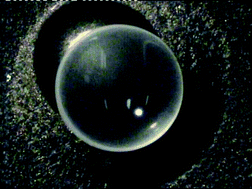Evaporative preconcentration and cryopreservation of fluorescent analytes using superhydrophobic surfaces†
Abstract
The preconcentration of analytes is important in biochemical analysis as it offers the ability to detect trace species, and increase signal-to-noise ratios when using optical sensing. A strong advantage of the evaporation technique lies in its ability to operate without any external energy source. We have found that the evaporation of droplets on typical surfaces is susceptible to the coffee staining effect that leaves remnant fluorescence on the surface. This is less pronounced with hydrophobic surfaces but shown here to be still significant. The use of a superhydrophobic surface is demonstrated to engender minuscule fluorescent material losses. The difficulty of locating a droplet on this surface is addressed here using wells in which a depth of 0.51 mm with 7 μl


 Please wait while we load your content...
Please wait while we load your content...